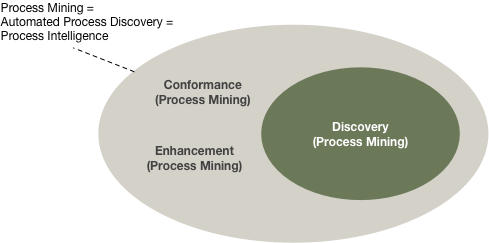It’s useful to have a shared terminology to avoid misunderstandings. During a recent discussion in the BPTrends Discussion Group at LinkedIn the terminology discussion about process mining has resurfaced.
In Wil’s book as well as in the process mining literature, the following picture (see below) is used to illustrate the scope of process mining technology. There is a classification that distinguishes techniques that, based on event logs,
-
discover and visualize process models (discovery),
-
compare a pre-defined or ideal process to the actual process (conformance), and
-
enrich discovered or existing models by additional information such as performance, cost, probabilities, or social structures (enhancement)
So, the basic idea of process mining is to extract knowledge from event logs recorded by an information system. The goal is to understand and improve actual processes based on factual information that was collected during the execution of these processes.
The problem is that different terms are used to describe log-based process analysis technology. I have seen these three (six)1 terms used to describe process mining-related ideas:
-
Process Mining (Business Process Mining)
-
Automated Process Discovery (Automated Business Process Discovery)
-
Process Intelligence (Business Process Intelligence)
But worse than that is that there are at least three different versions about the meaning of these terms.
First version
In the first version, the term ‘Automated Process Discovery’ is used as an alternative word for ‘Process Mining’ as defined above. Whether this is historically grown, to deliberately set a vendor apart, or simply because the term is seen as more descriptive is unclear.
It is true that process discovery is the core capability that initiated process mining research and arguably is the defining functionality of what makes a tool a process mining tool. And from a discovered process model it is natural to add further analysis perspectives2. For example, probabilities are added to the process visualization in this Automated Process Discovery wikipedia entry.
Second version
However, for many the term ‘Automated Process Discovery’ is understood in a more narrow sense, covering only the discovery part of process mining, which leads to the second—and most common—interpretation. In this version, ‘Automated Process Discovery’ is just a subset of ‘Process Mining’.
To clarify the true scope of process mining, thereby advocating to use the term ‘Process Mining’ rather than ‘Automated Process Discovery’, the following statement has been issued by the IEEE Task Force on Process Mining in their 2010 meeting3:
Process mining is not limited to process discovery, but also includes conformance checking, performance diagnosis, organizational mining, prediction, recommendation, etc. The key requirement is that analysis is based on “facts” (event log) and that process models play a role (either discovered or modeled) in this.
Third version
But even more confusing than the debate about ‘Process Mining’ vs. ‘Automated Process Discovery’ is the terminology used by some of the ‘Process Intelligence’ defenders. In this e-book about ‘Process Intelligence’ the term ‘Process Mining’ is defined as follows:
[Process mining is a] set of techniques to identify correlations within process data to identify bottlenecks and potential for optimization.
What they mean by that is a narrow feature that identifies process attributes with a high variation as these attributes might be influencing the performance of the process.
In contrast, ‘Process Intelligence’ is characterized as a set of tools and techniques for understanding an enterprise from a process perspective, much in the spirit of what is normally understood as process mining—leading to an interpretation where ‘Process Mining’ is just a tiny part of the actual process mining spectrum.
Where does that leave us?
It’s understandable that vendors want to coin their own terminology, and I am usually fine with using the term that the other person feels most comfortable with. However, it’s counter-productive in building up a professional discipline, where a shared understanding of terms and their meaning is essential for communication.
So, my recommendation is to stick with ‘Process mining’ as it is broader and more widely used. Process mining is more than the discovery of process models, although I see process discovery as the defining capability.
Have you yourself been confused by terminology issues around process mining? If so, in which situation? Let us know in the comments.
-
It’s usually also better to leave out the ‘business’ part as not only business processes can be analyzed by process mining techniques. ↩︎
-
In fact, also ‘Process Mining’ research started out under the term ‘Workflow Mining’ and has since evolved into the broader notion of analyzing log data from any IT system, not just workflow management systems, and beyond just process discovery. ↩︎
-
You can read the minutes of the 2010 IEEE Task Force on Process Mining meeting here. ↩︎




